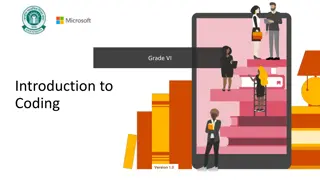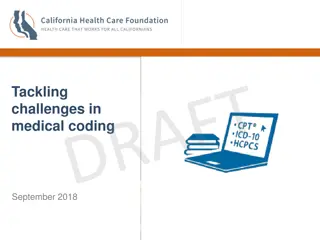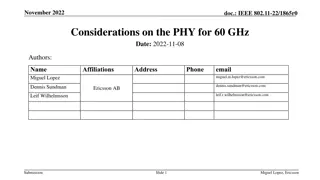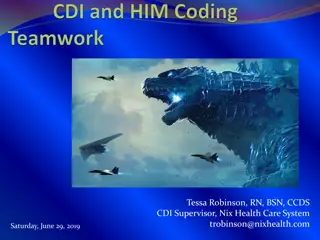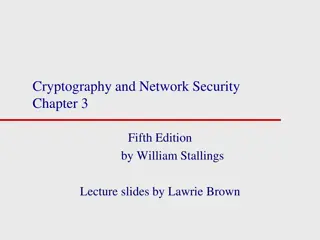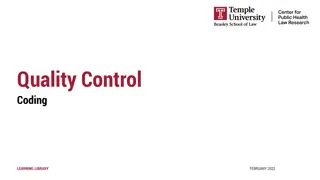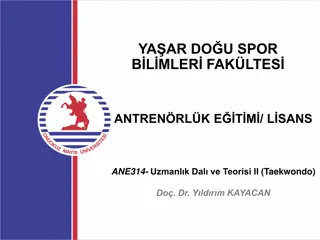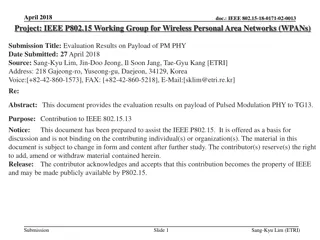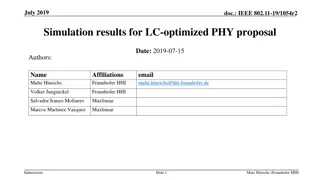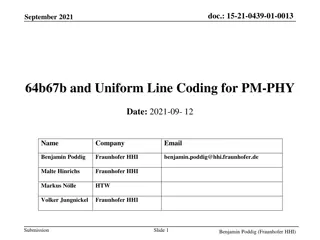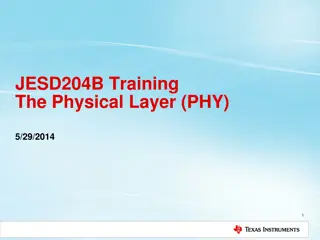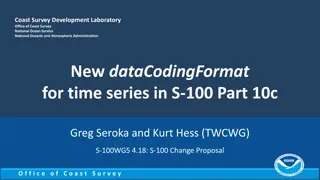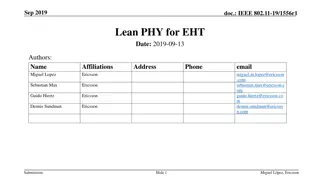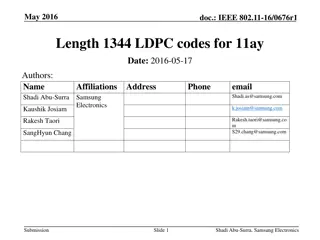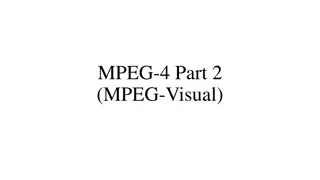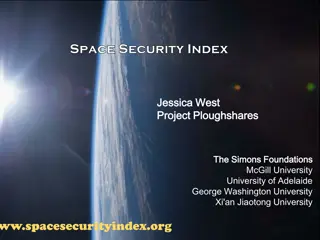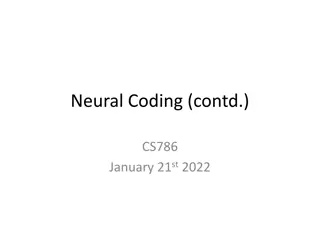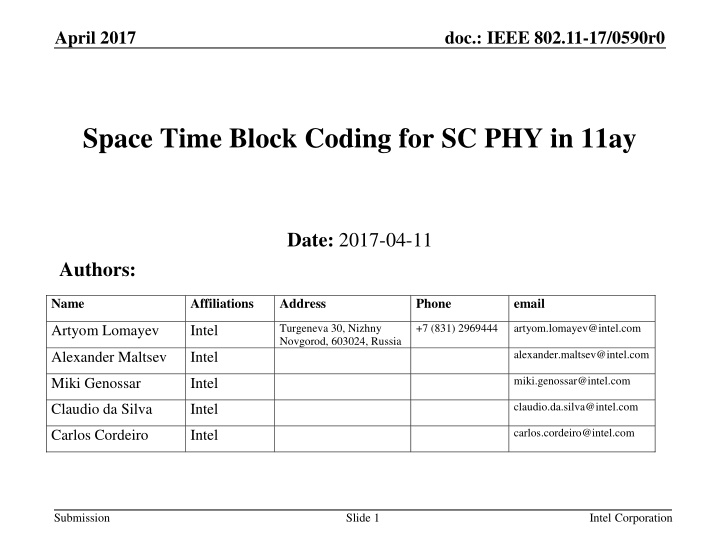
Space Time Block Coding for SC.PHY in 11ay
This presentation discusses a Space Time Block Code (STBC) for SC.PHY in 11ay, proposing a coding scheme and structure for improving signal transmission in the specified context. The STBC implementation involves mapping spatial streams, performing frequency domain code combining, and defining signal transmission processes in the frequency domain. Authors from Intel present detailed insights into how this STBC scheme can enhance data transmission efficiency, making it a valuable resource for those interested in wireless communication technologies.
Download Presentation

Please find below an Image/Link to download the presentation.
The content on the website is provided AS IS for your information and personal use only. It may not be sold, licensed, or shared on other websites without obtaining consent from the author. If you encounter any issues during the download, it is possible that the publisher has removed the file from their server.
You are allowed to download the files provided on this website for personal or commercial use, subject to the condition that they are used lawfully. All files are the property of their respective owners.
The content on the website is provided AS IS for your information and personal use only. It may not be sold, licensed, or shared on other websites without obtaining consent from the author.
E N D
Presentation Transcript
April 2017 doc.: IEEE 802.11-17/0590r0 Space Time Block Coding for SC PHY in 11ay Date: 2017-04-11 Authors: Name Affiliations Address Phone email +7 (831) 2969444 Turgeneva 30, Nizhny Novgorod, 603024, Russia artyom.lomayev@intel.com Artyom Lomayev Intel alexander.maltsev@intel.com Alexander Maltsev Intel miki.genossar@intel.com Miki Genossar Intel claudio.da.silva@intel.com Claudio da Silva Intel carlos.cordeiro@intel.com Carlos Cordeiro Intel Submission Slide 1 Intel Corporation
April 2017 doc.: IEEE 802.11-17/0590r0 Introduction This presentation proposes a Space Time Block Code (STBC) for SC PHY, [1]. Submission Slide 2 Intel Corporation
April 2017 doc.: IEEE 802.11-17/0590r0 SC Symbol Blocking for STBC The proposed STBC scheme applies coding to the data part of the SC symbol block and utilizes symbol blocking structure defined in [1]. It performs mapping of a single spatial stream (NSS = 1) to two space-time streams (NSTS = 2). The STBC code combining is performed in frequency domain in a similar way as for OFDM in 11n/ac, [2]. Submission Slide 3 Intel Corporation
April 2017 doc.: IEEE 802.11-17/0590r0 SC Symbol Blocking for STBC (Cont d) STBC coding: Input two SC symbol blocks xNSPB and yNSPB, NSPB defines the number of symbols per SC block; For example, let s define NSPB = 448 as in case of normal GI type; (x448(n), y448(n)) blocks are mapped to the first space-time stream; (-y*448(-n), x*448(-n)) blocks are mapped to the second space-time stream; (g1,64(n), g2,64(n)) are two Guard Intervals (GIs) of length 64 for space-time stream 1 and 2 accordingly; Figure below illustrates the proposed structure, (-n) defines reverse of symbols in time, * defines complex conjugation; GI DATA GI DATA GI STS #1 g1,64 g1,64 g1,64 x448(n) y448(n) STS #2 g2,64 g2,64 g2,64 -y*448(-n) x*448(-n) T1 T2 Submission Slide 4 Intel Corporation
April 2017 doc.: IEEE 802.11-17/0590r0 Signals Definition Transmit signals in frequency domain: STS#1: XT1(k) = X(k) + G1(k); YT2(k) = Y(k) + G1(k); where: X = DFT(x), Y = DFT(y), G1 = DFT(g1), G2 = DFT(g2); ( ) n ( ) n = = , 0 : 447 , 0 : 447 x n y n ( ) n ( ) n 448 448 = = x y = = , 0 448 : 511 , 0 448 : 511 n n = = , 0 n , 0 n 0 : 447 0 : 447 n n ( ) n ( ) n = = g g ( ) ( ) 1 2 = = 448 , 448 , g g 448 : 511 448 : 511 n n , 1 64 , 2 64 Submission Slide 5 Intel Corporation
April 2017 doc.: IEEE 802.11-17/0590r0 Signals Definition (Cont d) Received signals in frequency domain: Time interval T1: RT1(k) = H1(k)*X(k) ph(k)*H2(k)*Y*(k) + H1(k)*G1(k) + H2(k)*G2(k) + ZT1(k); Time interval T2: RT2(k) = ph(k)*H2(k)*X*(k) + H1(k)*Y(k) + H1(k)*G1(k) + H2(k)*G2(k) + ZT2(k); where: ph(k) = exp(+j(2 /512)* t*k), t = 65 chips; ZT1(k) and ZT2(k) AWGN ~CN(0, 2) noise samples; TX antenna #2 RX antenna #1 H2 Combiner H1 Noise Submission Slide 6 Intel Corporation
April 2017 doc.: IEEE 802.11-17/0590r0 Signals Definition (Cont d) Phasor explanation for STS#2: x*(-n) = ( x*(447), x*(446), , x*(0), 00, 01, , 063 ); Phasor operation applied in frequency domain makes cyclic shift in time domain as follows: x~(n) = (x*(0), 00, 01, , 063, x*(447), x*(446), , x*(1) ); Due to the property of DFT provided in Appendix, this gives complex conjugated subcarriers in frequency domain, i.e. X*(k) = DFT(x~(n)); Hence, DFT(x*(-n)) * exp(-j(2 /512)*65*k) = X*(k); and DFT(x*(-n)) = X*(k) * exp(+j(2 /512)*65*k); The same derivation is applicable for y*(-n) signal; Phasor can be treated as a part of H2 channel; Submission Slide 7 Intel Corporation
April 2017 doc.: IEEE 802.11-17/0590r0 Demodulation Method The combining method is similar to OFDM 11n/ac, the difference is that MMSE solution is used: The estimated X^(k) and Y^(k) signals can be written as follows: 2 ( ) ( ) k ( ) ( ) k ( ) k ( ) k 65 j k ^ X k R k * 1 1 H H e 512 = 1 T * 2 ( ) * ( ) k ( ) k 2 2 2 ^ Y + + R 2 H H + ( ) k ( ) k 65 j k * 2 H e H 2 T 512 1 2 1 This provides data estimation in the frequency domain, which in turn can be transformed to the time domain applying IDFT to get x^(n) and y^(n) estimations; Submission Slide 8 Intel Corporation
April 2017 doc.: IEEE 802.11-17/0590r0 Demodulation Method (Cont d) MMSE equalizer for GI part: The equalizer solution considered at the previous slide provides a perfect equalization of the data part only, but NOT for the GI part of the signal; After conversion to the time domain GI sequences will not be perfectly" equalized; Due to the fact that GI signals are known to receiver, they can be pre-calculated during channel estimation stage as follows: 2 ( ) ( ) k ( ) ( ) k ( ) ( ) k ( ) ( ) k ( ) ( ) k ( ) k ( ) k 65 j k + ~ 1 G k H k G k H k G k * 1 1 H H e 512 = 1 1 2 2 2 ( ) k ( ) k 2 2 2 + ~ 2 * 1 * 1 * 2 * 2 + + G H G H G 2 H H + ( ) k ( ) k 65 j k * 2 ) H e H 512 1 2 1 ( ) ( = = ~ 1 ~ 1 ~ 2 ~ 2 , g IDFT G g IDFT G The g~1 and g~2 signals can be used for phase tracking in time domain as known GIs; Submission Slide 9 Intel Corporation
April 2017 doc.: IEEE 802.11-17/0590r0 SP/M Do you agree: to include the text from (11-17-0587-00-00ay 30 5 6 4 3 Space Time Block Coding) defining SC STBC scheme to the spec draft? Submission Slide 10 Intel Corporation
April 2017 doc.: IEEE 802.11-17/0590r0 Appendix DFT complex conjugation property: 2 N 1 1 N N ( ) k ( ) n j nk = n DFT: = X x e 0 2 N 1 N 1 N ( ) k ( ) n j nk = n = * * Complex conjugated sample in frequency domain: X x e 0 2 2 2 1 ( ) k ( ) 0 ( ) 1 ( ) 2 ( ) 3 2 3 j k j k j k = + + + * * * * * Specific example for N = 4: X x x e x e x e 4 4 4 4 2 2 2 1 ( ) k ( ) 0 ( ) 1 ( ) 2 ( ) 3 2 3 2 2 2 j k j k j k j k j k j k Can be rewritten: = + + + * * * * * X x x e x e x e 4 4 4 4 2 2 2 1 ( ) k ( ) 0 ( ) 1 ( ) 2 ( ) 3 3 2 j k j k j k Using: = 2 je k = + + + * * * * * 1 X x x e x e x e 4 4 4 4 2 2 2 1 ( ) k ( ) 0 ( ) 3 ( ) 2 ( ) 1 2 3 j k j k j k = + + + * * * * * Reordering: X x x e x e x e 4 4 4 4 2 N 1 N 1 N ( ) k ( ) j nk = n In general case: = * * X x n e 0 Submission Slide 11 Intel Corporation
April 2017 doc.: IEEE 802.11-17/0590r0 References 1. Draft P802.11ay_D0.3 2. IEEE802.11-2016 Submission Slide 12 Intel Corporation


